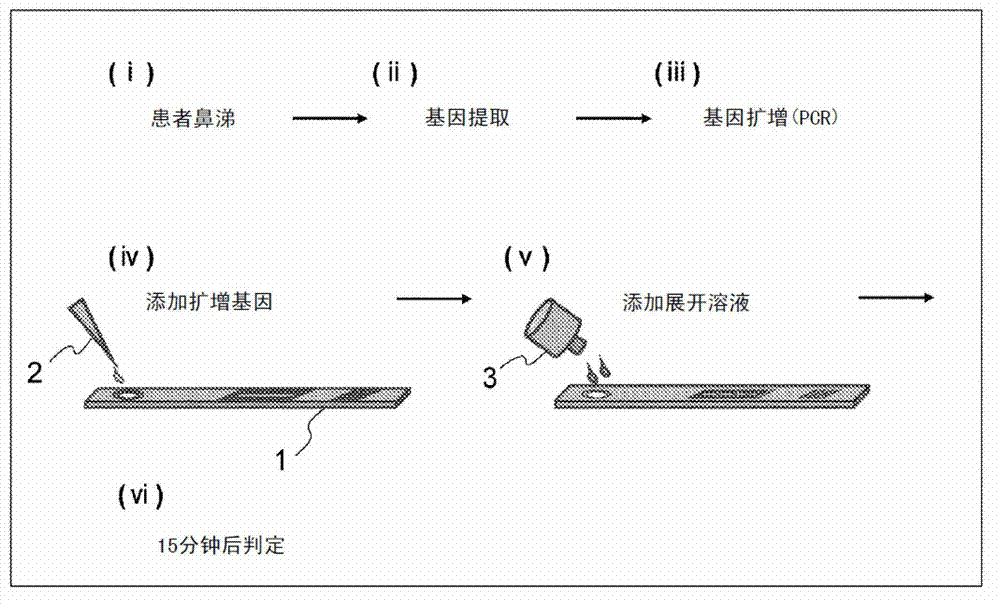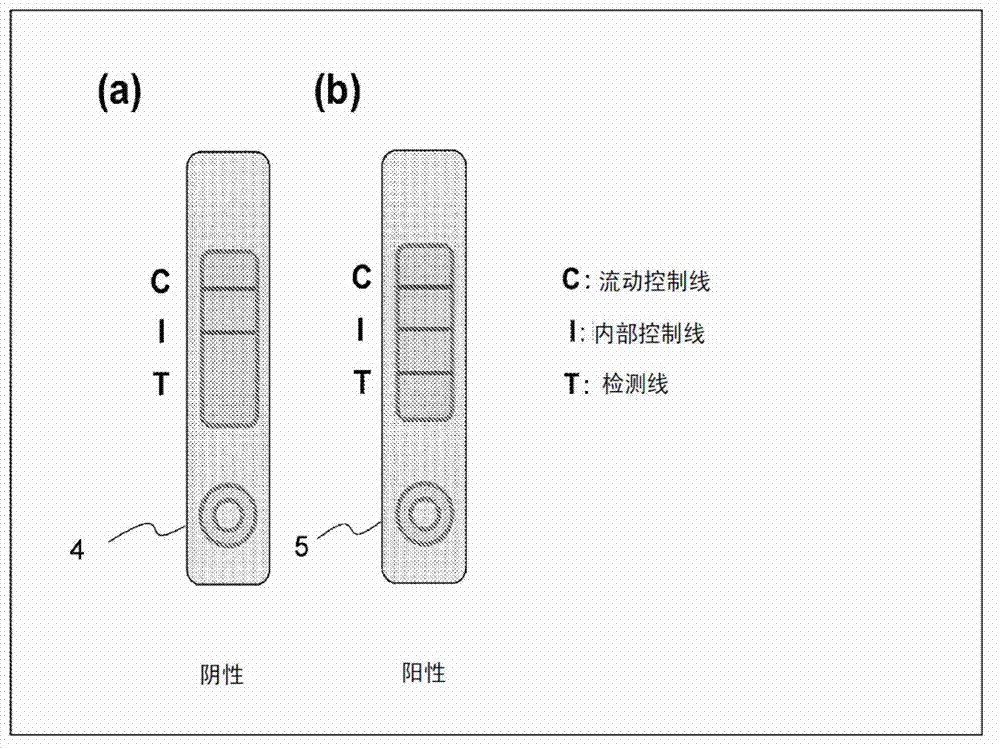Reagent composition for nucleic acid chromatography or immunochromatography, method for measurement by nucleic acid chromatography or immunochromatography, and kit for measurement by nucleic acid chromatography or immunochromatography
A technology of immunochromatography and composition, which is applied in the fields of reagent composition for nucleic acid or immunochromatography, nucleic acid or immunochromatography determination, and nucleic acid or immunochromatography assay kits, which can solve the problem that additives have not sufficiently achieved non-specific reactions Inhibition or sensitivity chromatographic carrier expansion, non-specificity, lack of sensitivity, etc., to achieve accurate and rapid judgment, promote specific reactions, and improve dispersion capabilities
- Summary
- Abstract
- Description
- Claims
- Application Information
AI Technical Summary
Problems solved by technology
Method used
Image
Examples
Embodiment 1~8 and comparative example 1~4
[0093] In the amount recorded in Table 1, 10% Tween20, 0.1M magnesium sulfate, dimethyl sulfoxide, 20% dextran sodium sulfate (weight average molecular weight: 500,000), and 2% of CE510 (JSR Corporation) and mixed. Further, 10% sodium azide was added as a preservative to make it 0.05%, and mixed to obtain a reagent composition.
[0094] [Table 1]
[0095]
Embodiment 9~14 and comparative example 5~9
[0097] Add 2% of a water-soluble polymer with a weight average molecular weight of 8,000 or more, 5mM of a divalent or trivalent metal salt, and 1% of a nonionic surfactant to ultrapure water of the type shown in Table 2 , 0.95% of a water-soluble aprotic organic compound, and 2% of CE510 (JSR Corporation) were mixed. Furthermore, 10% of sodium azide was added as a preservative to make it 0.05%, and mixed, and the reagent composition of Examples 9-14 was obtained.
[0098] Add 2% water-soluble polymer, 5mM metal salt, 1% surfactant, 0.95% isopropanol, 2% CE510 and 0.05% sodium azide and mixed to obtain the reagent composition of Comparative Examples 5-9.
[0099] [Table 2]
[0100]
[0101] [6. Measurement]
[0102] Using the chromatographic medium prepared above, the presence or absence of influenza A virus in the sample was determined by the following method. That is, when the gene of influenza A virus extracted from the nasal mucus of influenza virus-infected patient...
Embodiment 15 and comparative example 10~13
[0131] As recorded in Table 5, 1% of 10% Tween20, 5mM of 0.1M magnesium sulfate, 0.95% of dimethyl sulfoxide, 2% of 20% dextran sodium sulfate (weight average) were added to ultrapure water. Molecular weight: 500,000), and 2% of CE510 (JSR Corporation) and mixed. Furthermore, 10% of sodium azide was added and mixed as a preservative to 0.05%, and the reagent composition of Example 15 and Comparative Examples 10-13 was obtained.
[0132] [table 5]
[0133] Element
Amount added
Example 15
Comparative Example 10
Comparative Example 11
Comparative Example 12
Comparative Example 13
Sodium Dextran Sulfate
2%
○
○
○
○
magnesium sulfate
5mM
○
○
○
○
DMDO
0.95%
○
○
○
○
Tween 20
1%
○
○
○
○
[0134] [6. Measurement]
[0135] Using the chromatographic medium prepared above, the presence or absence of influenza A virus...
PUM
 Login to View More
Login to View More Abstract
Description
Claims
Application Information
 Login to View More
Login to View More - R&D Engineer
- R&D Manager
- IP Professional
- Industry Leading Data Capabilities
- Powerful AI technology
- Patent DNA Extraction
Browse by: Latest US Patents, China's latest patents, Technical Efficacy Thesaurus, Application Domain, Technology Topic, Popular Technical Reports.
© 2024 PatSnap. All rights reserved.Legal|Privacy policy|Modern Slavery Act Transparency Statement|Sitemap|About US| Contact US: help@patsnap.com










